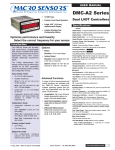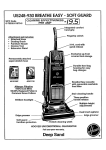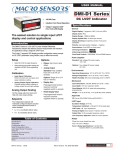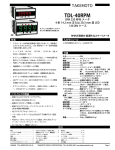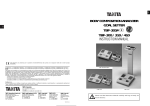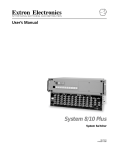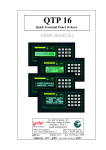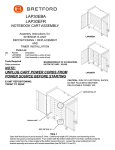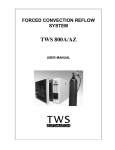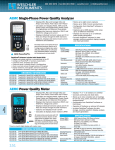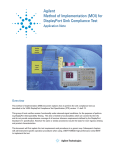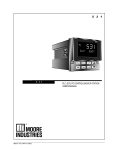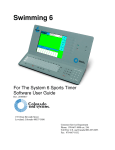Download DMI-A1 Series.qxp
Transcript
USER MANUAL DMI-A1 Series LVDT Indicators • 1/8 DIN Case • 3-button Front Panel Operation • 5-digit, 7-segment 0.56” (14.2 mm) LED Display The easiest solution to single input LVDT display and control applications Introduction The DMI-A1 Series are LVDT (Linear Variable Differential Transformer) indicators that deliver precise measurement and indication for applications using a single LVDT input. The 5-digit, 7-segment LED display provides configuration setup prompts for LVDT parameters using intuitive, easy to follow text menus. Setup Options • Select 50 or 60 Hz supply frequency. • Select decimal point position setting with resolution to 0.0001 of any engineering unit. • Locate the sensor NULL position. • Input Signal Calibration: Perform 2-point zero and span input signal calibration setting. Analog Output Signal Calibration: Calibrate analog output milliamp or voltage output low and high settings. Analog Output Scaling Set the analog output low (zero) and high (full scale) range settings. General Digital Display: 7-segment, 0.56” (14.2 mm) LEDs. Display Color: Red Display Range: -19999 to 99999. Display Update Rate: 10 times per second. Display Dimming: 8 brightness levels. Front panel selectable. Polarity: Assumed positive. Displays – negative. Annunciators: 6 red LEDs on front panel. Overrange Indication: Underrange Indication: Front Panel Controls: PROGRAM, UP, and DOWN buttons. Power Supplies Standard high voltage AC / DC power supply 85-265 V AC / 95-370 V DC. Optional low voltage AC / DC power supply 18-48 V AC / 10-72 V DC. Environmental • Analog Output Options 0/4 to 20 mA (or reverse). Calibration • • Relays: Four 5 amp relays. Specifications Single 0 to 10 V DC (or reverse). • Display Zero Preprogrammed function requires customer supplied switch to operate. • Reset Display Value Preprogrammed function requires customer supplied switch to operate. Operating Temperature: 0 °C to 50 °C (32 °F to 122 °F). Storage Temperature: -20 °C to 70 °C (-4 °F to 158 °F). Relative Humidity: 95% (non-condensing) at 40 °C (104 °F). Mechanical Case Dimensions: 1/8 DIN, 96x48 mm (3.78” x 1.89”). Case Depth: 137 mm maximum (5.39”). Case Material: 94V-0 UL rated self-extinguishing polycarbonate. Weight: 11.5 oz (0.79 lbs), 14 oz (0.96 lbs) when packed. Approvals CE: As per EN-61000-3/4/6 and EN-61010-1. LVDT Input Setpoints Four independent setpoints with individually configured setpoint actuation values, preprogrammed for above or below activation: • Lo 1, Lo 2 activates below value. • hi 1, hi 2 activates above value. Table of Contents Specifications . . . . . . . . . . . . . . . . . . . . . . . . . . . . . . . . . . . . . . . . . .1 Introduction . . . . . . . . . . . . . . . . . . . . . . . . . . . . . . . . . . . . . . . . . . .1 Configuration Menu . . . . . . . . . . . . . . . . . . . . . . . . . . . . . . . . . . . . .2 Supply Frequency and Decimal Point Setup . . . . . . . . . . . . . . . . . .3 Calibration Mode (LVDT Input Signal Calibration) . . . . . . . . . . . . . .4 Calibration Mode (Zero Options) . . . . . . . . . . . . . . . . . . . . . . . . . . .5 Calibration Mode (Analog Output Signal Calibration) . . . . . . . . . . .5 Analog Output Range Scaling Mode . . . . . . . . . . . . . . . . . . . . . . . .5 Setpoints . . . . . . . . . . . . . . . . . . . . . . . . . . . . . . . . . . . . . . . . . . . . .6 Input Signal Setup Procedures . . . . . . . . . . . . . . . . . . . . . . . . . . . .6 Connector Pinouts . . . . . . . . . . . . . . . . . . . . . . . . . . . . . . . . . . . . . .7 Installation . . . . . . . . . . . . . . . . . . . . . . . . . . . . . . . . . . . . . . . . . . . .9 Analog Output Scaling Example . . . . . . . . . . . . . . . . . . . . . . . . . . . .10 Analog Output Signal Calibration Example . . . . . . . . . . . . . . . . . . . .11 Serial Communications . . . . . . . . . . . . . . . . . . . . . . . . . . . . . . . . .13 31 May, 2006 DMI-A1 Series (ALD-00030) Macro Sensors Excitation Voltage: 3 V RMS sine wave, zero DC component THD <2% (1.2 kHz). Excitation Frequency: 50 Hz: 3.2 kHz. 60 Hz: 2.88 kHz. For other excitation frequencies contact Macro Sensors. Temperature Coefficient: ± 50 ppm/ ° C of full scale (typical). LVDT Input: 30 k input impedence. Synchronous demodulation of excitation carrier. >130 db rejection of excitation carrier. Frequency Response: 500 Hz (–3 db) low-pass filter. Analog to Digital: Single channel ΣΔ A/D convertor approaching 19-bit resolution. Ratiometric operation relative to excitation voltage magnitude. Output Rate: 10 Hz averaged response output. Line Frequency Rejection: 50 / 60 Hz noise rejection. Relays Plugs into carrier board from rear: Four 5 A Form A Relays. Form A Relay Specifications: 5 A 240 VAC. Isolation 3000 V. UL and CSA listed. Tel. (856) 662-8000 www.macrosensors.com 1 Configuration Menu The Configuration Menu shown opposite is a flow diagram of the DMI-A1 Series configuration menus and describes the settings and parameters that can be applied in each menu. OPERATIONAL DISPLAY Prog. SP1 SP2 SP3 SP4 SP5 SP6 Supply Frequency & Decimal Point P Start Prog. SP1 SP2 SP3 SP4 SP5 SP6 4 Secs Prog. Supply Frequency & Decimal Point The supply frequency and decimal point menu allows you to configure: P SP1 MIN MAX RANGE REL SP2 SP3 SP4 SP5 SP6 SP1 SP2 SP3 SP4 HOLD Hz PEAK MIN MAX mV V mA A V µA Prog. SP5 SP6 OFF A mA µA COM V + – SP5 Prog. SP6 SP1 SP2 SP3 SP1 SP2 SP3 SP4 SP1 SP5 SP2 Pin 2– Pin 3+ www.macrosensors.com SP4 SP5 SP6 P Takes you into the Setup menu that provides selection for: • Supply frequency: 50 or 60 Hz. • Decimal point position: No dp, 0.1, 0.12, 0.123, 0.1234. SP6 SP3 SP4 SP5 Prog. SP6 SP1 SP2 SP3 SP4 SP5 SP6 P Takes you into the Input Signal Calibration menu that provides selection for: • Locating sensor NULL position. • 2-point input signal calibration with zero and span settings. • Analog output signal calibration that provides analog output signal 0/4-20 mA or 0-10 V low and high calibration settings Analog Output Signal Range Scaling P Prog. SP1 SP2 SP3 Prog. Prog. SP1 SP2 SP3 SP4 SP5 SP6 SP4 SP1 SP5 SP2 SP6 SP3 SP4 SP5 Prog. SP6 SP1 SP2 SP3 SP4 SP5 SP6 P Takes you into the Analog Output Signal Range Scaling menu and allows you to set the low and high range settings for the calibrated analog output signal. Setpoints Start P Prog. SP1 SP2 SP3 SP4 SP5 SP6 Together Prog. SP1 SP2 SP3 SP4 SP5 SP6 Takes you into the Setpoints menu and allows you to set the setpoint activation value for the four setpoints. Setpoint Lo 1 and Lo 2 activate below the setpoint activation value, so that when the signal falls below the Lo 1 or Lo 2 value Lo 1 or Lo 2 activates. Setpoint hi 1 and hi 2 activate above the setpoint activation value, so that when the signal rises above the hi 1 or hi 2 value,hi 1 or hi 2 activates. Analog Output Signal Range Scaling The analog output module is a standard single channel, programmable, isolated, 16-bit analog output that can be scaled to any desired span between –19999 to 99999 display counts using the analog output signal range scaling menu. Setpoints The setpoints menu allows you to set the setpoint activation value for four separate setpoints (two low and two high) which can be used to activate the four 5A relays. TERMINAL 4 Figure 1 – Multimeter Connections 2 Prog. Prog. The analog output signal calibration menu allows you to calibrate the analog output’s milliamp or voltage output to suit your application. MULTIMETER SP4 NO changes reqd. P Calibration The LVDT input signal calibration menu allows you to set the null position of the sensor, if required, and also allows you to perform a 2-point zero and span calibration of the input signal. See Analog Output Procedures for an analog milliamp or voltage output calibration procedure. SP3 Input & Analog Output Signal Calibration • The position of the decimal point: No decimal point, 0.1, 0.12 (default), 0.123, 0.1234. Once the milliamp or voltage output is calibrated, the analog output range can be easily rescaled [An Lo] [An hi] using the analog output scaling mode without having to recalibrate the milliamp or voltage output. The calibrated low and high milliamp or voltage output signal values follow the new span range. SP2 Calibration • The power supply frequency: 50 or 60 Hz (60 Hz is the factory default setting). Calibrating the analog output requires setting the milliamp or voltage output low [CAL_L] and high [CAL_h] parameters using a multimeter connected to the analog output signal (See Figure 1 for an DMI-A1-100 to multimeter connection diagram). The calibrated low and high outputs can be set anywhere between –0.3 to +21 mA for current or –0.3 V to +10.5 V for voltage. SP1 Display Zero and Reset Display Value The DMI-A1 Series indicators are programmed with a display zero and reset display value function. The Macro Sensors Tel. (856) 662-8000 display zero function is used to zero the display when the sensor is in any position. Display zero is initiated from a remote switch (not supplied) connected across the common and hold pins at the rear of the controller (Terminal 2: Pin 4 Common, Pin 2 Hold). The reset display value function is used to restore the true calibrated value on the display. Reset display value is initiated from a remote switch (not supplied) connected across the common and lock pins at the rear of the controller (Terminal 2: Pin 4 Common, Pin 1 Lock). The display zero value and reset display value are not retained during a power outage. The display zero and reset display value functions are often used for cut, measure, and trim applications. 31 May, 2006 DMI-A1 Series (ALD-00030) Supply Frequency & Decimal Point Setup The supply frequency & decimal point setup mode allows you to configure the power supply frequency and the position of the display decimal point. Supply Frequency & Decimal Point Setup P Supply Frequency 60 Hz Selection Prog. Prog. SP1 SP2 SP3 SP4 SP5 Prog. SP6 4 Secs Prog. SP1 SP2 SP3 SP4 SP5 SP6 Prog. SP1 SP2 SP3 SP4 SP5 SP6 P SP1 SP2 Prog. SP3 SP4 SP1 SP5 SP2 SP1 SP3 SP2 SP4 SP5 SP6 SP6 SP3 SP4 SP5 [ 1.92] P YES SP6 Prog. SP1 SP3 SP2 SP4 SP5 SP6 [ 2.88] [ 3.84] Select sensor excitation frequency according to sensor specification to optimize performance. OR [ 5.76] [ 7.68] [ 9.60] [ 11.52] 50 Hz Selection Prog. Prog. YES SP1 SP2 SP3 SP4 SP5 YES SP6 SP1 P SP3 SP2 SP4 Prog. SP5 SP1 SP6 SP3 SP2 SP4 SP5 SP6 [ 1.6] [ 2.4] Note: For optimum performance, most [ 3.2] Macro Sensors LVDTs operate at a standard excitation frequency of 2.88 (60 Hz) or 3.2 (50 Hz) [ 4.8] [ 6.4] [ 8.0] [ 9.6] Display Output Rate Filter Prog. SP1 SP2 SP3 SP4 SP5 SP6 P Prog. SP1 SP2 SP3 SP4 SP5 SP6 Prog. SP1 SP2 SP3 SP4 SP5 SP6 Prog. SP1 SP2 SP3 SP4 SP5 SP6 Prog. SP1 SP2 SP3 SP4 SP5 SP6 OR OR Prog. Decimal Point P Prog. SP1 SP2 Prog. SP3 SP4 SP1 SP5 SP2 SP1 SP2 SP3 SP4 SP5 SP6 SP6 SP3 SP4 SP5 Prog. SP1 SP2 SP3 SP4 SP5 SP6 Prog. SP1 SP2 SP3 SP4 SP5 SP6 SP6 Default Prog. SP1 SP2 SP3 SP4 SP5 SP6 Calibration Input & Analog Output Signal Calibration P Prog. SP1 SP2 Prog. SP3 SP4 SP1 SP5 SP2 YES SP6 SP3 SP4 SP5 SP6 Press the button to enter the Calibration Mode See Page 4 for further details P Or press the P button 2 times to EXIT (bypassing the analog setup) and return to the Operational Display 31 May, 2006 DMI-A1 Series (ALD-00030) Macro Sensors Tel. (856) 662-8000 www.macrosensors.com 3 Calibration Mode (LVDT Input Signal Calibration) The Calibration Mode is divided into two separate sections; These are: a) calibration of the LVDT input signal and b) calibration of the analog output signal • Adjusting the LVDT to a null position. • A dual position, zero and span calibration procedure. The Input Signal Calibration mode is used to calibrate the physical position of the sensor to the meter display. The Input Signal Calibration mode provides two individual calibration techniques which are shown in the diagram below. Note: Calibration procedures can not be carried out on a signal if the signal has an active linearization table. The table or tables must be disabled before calibration and then re-activated when calibration is complete. Supply Frequency & Decimal Point Setup P Prog. SP1 SP3 SP2 SP4 SP5 Press the button to enter the Supply Frequency & Decimal Point Setup See Page 3 for further details SP6 4 Secs Prog. SP1 SP3 SP2 SP4 SP5 SP6 P Calibration CAUTION: Do not enter the Calibration menu unless you are sure you want to change the calibration parameters. Input Signal Calibration P Prog. SP1 SP3 SP2 Prog. SP4 SP1 SP5 SP3 SP2 Prog. SP6 SP4 SP5 Prog. SP6 SP1 SP3 SP2 SP4 SP5 SP6 P SP1 SP2 SP3 Prog. SP4 SP1 SP5 SP2 Adjust the sensor to locate the NULL position. Example Sensor LVDT Sensor NULL position must be located before calibration to ensure correct operation. NULL POSITION SP6 SP3 SP4 SP5 SP6 Example P Prog. SP1 SP3 SP2 Prog. SP4 SP1 SP5 SP3 SP2 Prog. SP6 SP4 SP5 Prog. SP6 SP1 SP2 SP3 SP4 SP5 SP6 P SP1 SP2 SP3 Prog. SP4 SP1 SP5 SP2 Adjust the sensor to the required zero position. Adjust the display value using the buttons. Press the P button to accept the sensor's new zero value. Example Sensor SP6 SP3 x2 SP4 SP5 SP6 Max counts 99999 Example Min counts –19999 ZERO POSITION P Prog. SP1 SP2 SP3 Prog. SP4 SP1 SP5 SP2 Adjust the sensor to the required span position. Adjust the display value using the buttons. Press the P button to accept the sensor's new span value. Example Sensor Max counts 99999 SP6 SP3 SP4 SP5 SP6 Example P Prog. SP1 SP3 SP2 Prog. SP4 SP1 SP5 SP2 Prog. SP6 SP3 Min counts –19999 SPAN POSITION Analog Output Signal Calibration SP4 SP5 Prog. SP6 x3 SP1 SP2 SP3 SP4 SP5 SP6 P P [ PrESS P And uP] Prog. Scrolls across display SP1 SP2 SP3 SP4 SP5 SP6 SP1 SP2 Prog. SP3 SP4 SP1 SP5 SP2 SP6 SP3 SP4 SP5 SP6 Together DMI-A1 Connected to Multimeter Prog. P SP1 SP2 Prog. SP3 SP4 SP1 SP5 SP2 Prog. SP6 SP3 SP4 SP5 SP6 P SP2 SP3 Prog. Prog. P SP1 SP1 SP2 Prog. SP4 SP1 SP3 SP4 SP1 SP5 SP2 SP5 SP2 Ensure the correct low analog output signal reading [CAL_L] is shown on the multimeter. SP6 SP3 SP4 SP5 SP6 Ensure the correct high analog output signal reading [CAL_h] is shown the multimeter. SP6 SP3 If not correct, press the OR button on the DMI-A1 until the reading on the multimeter display is correct. SP4 SP5 SP6 If not correct, press the OR button on the DMI-A1 until the reading on the multimeter display is correct. Max counts 99999 Min counts –19999 Max counts 99999 Min counts –19999 Together Prog. SP1 P SP2 SP3 Prog. SP4 SP1 SP5 SP2 SP6 SP3 SP4 SP5 SP6 P Analog Output Range Scaling Prog. P SP1 SP2 Prog. SP3 SP4 SP1 SP5 SP2 Prog. SP6 SP3 SP4 SP5 SP6 P SP1 SP2 SP3 Prog. SP4 SP1 SP5 SP2 Set the counts required to be displayed for the calibrated low analog output value using the buttons. Press the P button to accept the new low value. SP6 SP3 SP4 SP5 Max counts 99999 Min counts –19999 SP6 Default Prog. P SP1 SP2 Prog. SP3 SP4 SP1 SP5 SP2 Set the counts required to be displayed for the calibrated high analog output value using the buttons. Press the P button to accept the new high value. SP6 SP3 SP4 SP5 SP6 Max counts 99999 Min counts –19999 Default 4 www.macrosensors.com Macro Sensors Tel. (856) 662-8000 31 May, 2006 DMI-A1 Series (ALD-00030) Calibration Mode (Zero Options) NULL The NULL position allows the user to adjust the LVDT core until the LVDT output is zero. The sensor must be brought to NULL position before calibrating. The "NULL" position is the physical point at which the LVDT output is "electrically centered" (neither positive or negative). This corresponds roughly to the mechanical center of the unit. Please refer to the "N" dimension on the line drawing of your particular LVDT at www.macrosensors.com. The display zero function is used to zero the display. Display zero is initiated from a remote momentary switch (not supplied) connected across the common and hold pins at the rear of the controller (Terminal 2: Pin 4 Common, Pin 2 Hold). Display Zero and Reset Display Value Function The reset display value function is used to restore the true calibrated value on the display. Reset display value is initiated from a remote momentary switch connected across the common and lock pins at the rear of the controller (Terminal 2: Pin 4 Common, Pin 1 Lock). The controller has been programmed with a display zero and reset display value function that operates on the selected primary display reading only. The display zero value and reset display value are not retained during a power outage. The display zero and reset display value functions are often used for cut, measure, and trim applications. Calibration Mode (Analog Output Signal Calibration) Calibrating the analog output means ensuring the LOW and HIGH analog output signals are correct using a calibration device such as a multimeter. This should not be confused with calibrating the physical position of the sensor to the meter (see page 4)! Calibration requires setting the [CAL_L] and [CAL_h] parameters. [CAL_L] is used to set the calibrated low analog output, and [CAL_h] is used to set the calibrated high analog output. The calibrated low and high outputs can be set anywhere between –0.3 to 21 mA for current, or –0.3 to 10.5 V for voltage. • Check the analog output scaling (zero and full scale display settings) and if necessary, carry out the analog output scaling procedure to set zero and full scale settings. • Check the analog output on the multimeter at the zero and full scale display settings and, if required, carry out the analog output calibration procedure to calibrate the millamp (or voltage) output low and high settings. A step by step procedure that shows an actual example of how to calibrate the analog output signal is shown on page 11 of this manual. Before calibrating the analog output: • See Figure 1. Connect a multimeter to the analog output connector at the rear of the meter (Terminal 4: Pin 3 positive, Pin 2 negative). • Make sure the multimeter is set to read the appropriate signal type: volts or milliamps. Note: Calibration procedures can not be carried out on a signal if the signal has an active linearization table. The table or tables must be disabled before calibration and then re-activated when calibration is complete. Analog Output Range Scaling Mode The analog output module is a standard single channel, programmable, isolated, 16-bit analog output that can be scaled to any desired span between –19999 to 99999 display counts using the analog output scaling mode. Range Scaling Range scaling requires setting the low analog output value [Ao_Lo] and high analog output value [Ao_hi] of the analog output. The low value is the display setting at which the analog output is required to be at its calibrated low output. The high value is the full scale display setting at which the analog output is required to be at its calibrated high output. There are no limits to the difference between the zero and full scale settings. The difference can be anywhere between 1 count and the entire display range of the meter. A step by step procedure that shows an actual example of how to scale the analog output is shown on page 10 of this manual. 31 May, 2006 DMI-A1 Series (ALD-00030) Macro Sensors Tel. (856) 662-8000 www.macrosensors.com 5 Setpoints Setpoint Activation Setpoints The four setpoints are grouped together in two pairs: START P Prog. SP1 SP2 SP3 SP4 SP5 Max counts 99999 SP6 Together Prog. SP1 SP2 SP3 SP4 SP5 SP6 Default P Prog. SP1 SP2 SP3 Prog. SP4 SP1 SP5 SP2 Max counts 99999 SP6 SP3 SP4 SP5 SP6 Default P • Setpoint Lo 2 (SP3) and hi 2 (SP4). Low setpionts Lo 1 and Lo 2 are programmed to activate on a falling signal below the setpoint activation setting. High setpionts hi 1 and hi 2 are programmed to activate on a rising signal above the setpoint activation setting. Min counts –19999 ABOVE Prog. SP1 SP2 SP3 Prog. SP4 SP1 SP5 SP2 Max counts 99999 SP6 SP3 SP4 SP5 SP6 Default P Min counts –19999 • Setpoint Lo 1 (SP1) and hi 1 (SP2). Prog. SP1 SP2 Prog. SP3 SP4 SP1 SP5 SP2 Falling LVDT Signal hi 1 / hi 2 BELOW Max counts 99999 SP6 SP3 ACTIVATION SP Lo 1 / Lo 2 SP Min counts –19999 Rising LVDT Signal SP4 SP5 SP6 Default Min counts –19999 Input Signal Setup Procedures Technical Description LVDT 1 See Figure 2. The LVDT smart input module is designed to drive and condition the signal from an LVDT transducer. The module contains two high-speed microcontrollers and a synchronous demodulator 16-bit dual channel A/D convertor. It communicates with a DMI-A1 indicator via the I2C data bus. One of the microcontrollers generates the sine wave for the LVDT excitation frequency. The frequency is produced as multiples of the line frequency (either 50 Hz or 60 Hz). The output to the primary coil of the LVDT is a 3 V RMS sine wave. The received LVDT signal is synchronously demodulated and filtered to remove the carrier frequency. The Σ Δ 16-bit A/D convertor has over 130 dB noise rejection at the excitation frequency. + 5V — 5V GND 500 Hz LPF + SIGNAL 1 + 24 V —SIGNAL 1 16-Bit ATD Synchronous Demodulator SHIELD 3 V RMS Audio Sine wave Generator 16 Programmable Excitation Frequencies Microcontroller I2C Bus DMI-A1 Interface +24V PCB 345 Figure 2 – LVDT Smart Input Module Functional Schematic LVDT + SIGNAL — SIGNAL PIN 1 — EXC + EXC PIN 3 PIN 2 PIN 4 Not Connected Not Connected Not Connected Not Connected PIN 5 Not Connected GND SHIELD PIN 9 PIN 6 PIN 7 PIN 8 PIN 10 PIN 11 34 Figure 3 – Example LVDT Input Connection to LVDT Smart Input Module 6 www.macrosensors.com Macro Sensors Tel. (856) 662-8000 31 May, 2006 DMI-A1 Series (ALD-00030) Connector Pinouts All external connections to the DMI-A1 is via the following six connector terminal blocks located at the rear of the controller: • Terminal 1: LVDT Input Signals. • Terminal 2: Function Pins. • Power: AC / DC Power Supply. • Terminal 4: Analog Output (optional). • Terminal 5: Serial Output (optional). • Terminal 6: Relay Output Module. TERMINAL 5 Serial Output TERMINAL 6 Output Module TERMINAL 4 Analog Output 1 2 345 6 2 1 5 4 3 6 6 7 8 Dual Analog Output ONLY 2 1 8 7 TERMINAL 2 Function Pins TERMINAL 1 Input Module 1 2 3 4 5 DMI-A1 indicators use plug-in type screw terminal connectors for most input and output connections, an RJ-11 phone connector for the optional RS-232 serial output, and an RJ-45 phone connector for the optional Ethernet output. 9 10 11 1 2 3 LOCK HOLD TEST POWER 1 5 4 3 2 COM CAPTURE WARNING: AC and DC input signals and power supply voltages can be hazardous. Do not connect live wires to screw terminal plugs, and do not insert, remove, or handle screw terminal plugs with live wires connected. Figure 4 – Rear Panel Pinout Diagram Connector TERMINAL 1 Input Signals Pins 1 up to 11 TERMINAL 2 Pin Description 1 2 3 4 5 6 7 8 9 10 11 + Signal – Signal –Excitation +Excitation Not Connected Not Connected Not Connected Not Connected Not Connected Ground Shield LVDT Smart Input Module 1 Reset Display Value (Lock) By connecting Pin 1 (lock) to Pin 4 (common) with a remote spring-return switch restores the display to the true calibrated value. 2 Display Zero (Hold) By connecting Pin 2 (hold) to Pin 4 (common) with a remote spring-return switch zeroes the display. 3 Display Test and Reset Pin 3 (display test and reset pin) provides a test of the controller’s display and resets the microprocessor when Pin 3 is connected to Pin 4. 4 Common To activate the hold, test and reset, or lock pins from the rear of the controller, the respective pins have to be connected to the common pin. 5 - - Function Pins Pins 1 to 5 Name + SIGNAL — SIGNAL PIN 1 PIN 2 — EXC + EXC PIN 3 PIN 4 Not Connected Not Connected Not Connected Not Connected PIN 5 Not Connected GND SHIELD PIN 9 PIN 6 PIN 7 PIN 8 PIN 10 PIN 11 345 For further details on the function pins, contact Macro Sensors. POWER 1 AC Neutral / DC – Auto Sensing AC / DC Power Supply 2 AC Line / DC + The power connector supplies AC / DC power to the controller via a standard high voltage or optional low voltage auto-sensing power supply mounted on the main board. PS1: Standard High Voltage option. 85-265 V AC / 95-370 V DC. PS2: Optional Low Voltage option. 14-48 V AC / 10-72 V DC. Pins 1 and 2 31 May, 2006 DMI-A1 Series (ALD-00030) Macro Sensors Tel. (856) 662-8000 www.macrosensors.com 7 Pin Connector TERMINAL 4 Analog Outputs Pins 1 to 3 Name Description TERMINAL 4 connects the analog output module to external devices. A single 0~4 to 20 mA (standard) or (optional) 0 to 10 V DC is supported on the standard or Ethernet carrier board. 1 - - 2 Negative (–) Negative for Analog Output. 3 Positive (+) Positive for Analog Output . TERMINAL 5 TERMINAL 5 connects an optional serial output module to external devices. Serial Outputs The standard carrier board supports a single or dual RS-232 ASCII or Modbus serial card connected thru an RJ-11 socket. Pins 1 up to 8 STANDARD CARRIER BOARD Pin No. RJ-11 1 2 3 4 5 6 1 2 3 4 5 6 7 RJ-45 TERMINAL 6 Relay Outputs Pins 1 up to 8 8 ETHERNET CARRIER BOARD RS-232 (ASCII or Modbus) RJ-11 Socket Single Output RJ-45 Socket (10/100 Base-T) Dual Output 1 Reserved for future use RXD1 White/Orange TXD+ 2 Isolated Ground 0V Orange TXD– 3 +5 VDC to power external converters 0 V1 White/Green RXD+ 4 TXD. Transmitted Serial Blue – 5 RXD. Received Serial RXD White/Blue – 6 Reserved for future use TXD1 Green RXD– 7 Not applicable Not applicable White/Brown – 8 Not applicable Not applicable Brown – TXD The Ethernet carrier board uses an RJ45 socket at 10/100 Base-T. 8 TERMINAL 6 connects electromechanical relays to external applications. 1 2 3 4 5 6 7 8 Normally Open Common SP4 Normally Open Common SP3 Normally Open Common SP2 Normally Open Common SP1 www.macrosensors.com SP4 With 4 relays installed, an 8-pin connector block is used. Relay Modules with Four 5 A Form A Relays SP4 SP3 SP2 SP1 SP3 SP2 1 2 3 4 5 6 7 8 SP4 SP3 SP2 SP1 5A 5A 5A 5A SP1 Macro Sensors Tel. (856) 662-8000 31 May, 2006 DMI-A1 Series (ALD-00030) Installation PANEL CUTOUT FRONT VIEW Case will mount in standard 1/8 DIN coutouts 1/8 DIN 96x48mm 4 mm (0.16") 8 places Mosaic Fitting 87.4 mm (3.45") 43.4 mm 40.8 mm (1.71") (1.61") 91.6 mm Snug Fitting (3.6") 3 12") 8 places 1/8 DIN Cutout spacers 92 mm (3.62") Prog. Loose Fitting Metal Surround Case uses Metal Screw Mount Clips and has a max. panel thickness mounting of 15.5 mm (0.61"). 48 mm (1.89") 45 mm (1.77") SP1 SP2 SP3 SP4 SP5 96 mm (3.78") Metal Surround Case: These dimensions are increased by 1.6 mm (0.06") when the metal surround case is installed. Removable Key-lock Cam Opening When extra panel mounting tightness is required, order the optional screw mount clip. P/N:(OP-MTLCLIP) 117 mm (4.61") 5.3 mm (0.21") g. Pro (1.61") SP6 Metal Surround Case (P/N: OP-MTL96X48) NOTE: The Metal Surround Case is pre-installed at the factory and cannot be removed without damage to the case. Safety Catch Panel adaptor plates are available to retrofit most 40.8 mm existing panel cutouts. 43.4 mm (1.71") DIN Cutout spacers 3.9 mm (0.15") typical Clear Lockable NEMA 4X Splash Proof Cover P/N:(OP-N4/96x48) Straight-thru Connector for meters with output board 20 mm (0.79") SIDE VIEW 3.7 mm (0.15") SP1 Max. panel thickness 50mm (1.97") SP6 SP5 SP4 SP3 SP2 96 mm (3.78") TOP VIEW To open rear cover, use a small flat blade screw driver. Press down lightly to release catch on top or bottom of case and lever outwards. 91.6 mm (3.6") DIN Cutout Spacer Various bezel colors are available. Black is standard. 4.7 mm (0.19") DIN Cutout Spacer Right-angled Connector 11.8 mm (0.47") Prog. SP1 SP2 SP3 SP4 SP5 SP6 Prog. SP1 SP2 SP3 SP4 SP5 SP6 95.4 mm (3.77") Macro Sensor's 96x48 mm 87.4 mm (3.45") mosaic fitting For additional strength, extra Mounting Slide Clips can be ordered and doubled up one behind the other. P/N: (75-DMTCLIPF) case is particularly suitable for mounting in mosaic panels or insulative panels up to 2" thick. They can also stack mount, 2 up in existing cutouts for 1/4 DIN (96x96 mm) or 4 up in 1/2 DIN (96X192 mm). 2 mm (0.08") Connector Socket Installation Procedure WARNING AC and DC power supply voltages are hazardous. Make sure the power supply is isolated before connecting to the meter. STEP A 1) Prepare the Panel STEP B STEP C Connect the Cables 1) Remove both mounting clips from the meter. 1 1) Connect all input and output signal cables to the connector pins (See Connector Pinouts for details). 2) Push the meter into the panel cutout from the front of the panel. 2 2) Connect the power cables to the connector pins (See Connector Pinouts for details). 3) Cut a hole in the panel to suit the panel cutout. See panel cutout sizes above. 1 Install the Meter Attach both mounting clips to the meter from the rear of the panel and push them towards the front of the panel until the meter is firmly held. 3 2 3 Figure 5 – DMI-A1 Series Installation Sequence 31 May, 2006 DMI-A1 Series (ALD-00030) Macro Sensors Tel. (856) 662-8000 www.macrosensors.com 9 Analog Output Scaling Example In this example the analog output signal is scaled over a range of 50 to 3000 counts. Scaling the Analog Output Signal STAR T HERE START Operational Display Prog. Prog. Step 1 SP2 SP3 SP4 SP5 SP1 SP2 SP3 SP4 SP5 SP6 SP6 Press for 4 secs Press the P button for 4 secs Step 6 Prog. SP1 SP3 SP2 SP4 SP5 SP6 OR Adjust the display to 3000 counts for the high analog output scale setting Prog. SP1 SP2 Prog. Step 2 SP3 SP4 SP5 SP6 Example SP1 SP2 SP3 SP4 SP5 SP6 Prog. Press Press the P 2 button two times to skip the Supply Frequency and Decimal Point Setup and Calibration modes and enter the Analog Output mode Step 3 SP1 Step 7 Press the P button to accept the new high value Prog. SP1 SP3 SP2 SP4 SP5 SP1 SP2 SP3 SP4 SP5 SP6 Press 1 Scaling of the analog output signal is now complete! SP6 Press 1 Press the P button to confirm the Analog Output Selection. Prog. Prog. Step 4 SP1 SP2 Prog. SP3 SP4 SP1 SP5 SP2 SP1 SP2 SP3 SP4 SP5 SP6 SP6 SP3 SP4 SP5 SP6 OR Adjust the display to 50 counts for the low analog output scale setting Example Prog. Step 5 Press the P button to accept the new low value SP1 SP2 SP3 SP4 SP5 SP6 Press 1 To Step 6 10 www.macrosensors.com Macro Sensors Tel. (856) 662-8000 31 May, 2006 DMI-A1 Series (ALD-00030) Analog Output Signal Calibration Example Calibration of the Analog Output Signal From Step 9 Operational Display STAR T HERE START Prog. Step 1 Press the P button for 4 secs SP1 SP2 SP3 SP4 SP5 With the DMI-A1 connected to a multimeter, the DMI-A1 displays [CAL] [151]. This is the setting for analog output 1. Press for 4 secs Prog. Step 2 X Select Enter Prog. Step 10 SP6 SP1 SP2 SP3 SP4 SP5 SP1 SP2 SP4 SP3 SP4 SP1 SP5 SP2 SP6 SP3 SP4 SP5 SP6 DO NOT CHANGE THIS SETTING. Press 1 Press P to start the calibration procedure SP6 SP3 SP2 Prog. MULTIMETER Prog. SP1 SP5 Prog. SP1 SP2 SP3 SP4 SP5 SP6 SP6 MIN MAX RANGE REL HOLD Hz PEAK MIN MAX Prog. mV Step 11 Step 3 Enter the Supply Frequency menu Prog. X Step 4 X Pass thru the Decimal Point menu SP3 SP4 SP5 SP1 SP2 SP3 SP4 SP5 If not correct, press the OR button on the DMI-A1 until the reading on the multimeter display is correct. SP6 µA SP1 SP2 SP3 SP4 SP5 SP6 OR TERMINAL 4 Pin 2– A mA µA Pin 3+ COM V X + – MULTIMETER MIN MAX RANGE REL Example HOLD Hz PEAK MIN MAX mV V mA A V µA Prog. Prog. SP1 SP2 SP3 SP4 SP5 Step 12 SP6 SP2 Prog. SP3 SP4 SP1 SP5 SP2 SP3 SP4 Press 1 + – Step 13 SP6 SP5 MIN MAX SP2 SP3 SP4 SP5 SP2 SP4 SP5 SP6 SP2 SP3 SP4 Pin 3+ SP5 SP6 Hz Prog. mA A V µA A mA µA COM V SP1 SP2 SP3 SP4 SP5 SP6 OR TERMINAL 4 X Pin 2– Pin 3+ + – MULTIMETER SP6 SP3 SP4 HOLD V OFF RANGE REL SP1 SP3 PEAK MIN MAX MIN MAX Prog. RANGE REL SP1 mV If not 10.00 V DC, press the OR button on the DMI-A1 until the reading on the multimeter display is correct. SP1 SP2 Pin 2– Prog. MULTIMETER Ensure the high analog output signal reading [CAL_h] on the multimeter display is 10.00 V DC. SP6 SP1 COM V TERMINAL 4 Save the low analog output signal setting. Enter analog output high signal calibration SP1 mA µA A Step 6 Press the button 3 times to jump to the Output menu V OFF Press 1 Prog. mA A OFF Ensure the low analog output signal reading [CAL L] on the multimeter display is 0.00 V DC. SP6 Press 1 Prog. Step 5 SP2 Press 1 Prog. Pass thru the Supply Frequency menu SP1 V SP5 SP6 HOLD Hz PEAK MIN MAX Press x3 mV V mA A V µA OFF A Prog. Step 7 Enter the Analog Output menu Step 14 SP1 SP2 SP3 SP4 SP5 Press P button to leave the CAL menu SP6 Press 1 mA µA COM V X Step 8 X Display scrolls [PrESS P and uP] Press Press P and at same time buttons at the same time Prog. Step 9 X Press P to enter the Calibration menu Press SP1 SP2 Prog. SP1 SP2 Prog. SP3 SP4 SP1 SP3 SP2 SP4 SP1 SP5 SP2 SP4 SP5 SP6 Press 1 SP6 SP3 SP4 SP5 SP6 Step 15 Press at same time Press P and buttons at the same time to return to the operational display To Step 10 1 31 May, 2006 DMI-A1 Series (ALD-00030) SP2 SP3 SP4 SP5 SP6 Pin 2– SP1 SP2 SP3 SP4 SP5 Pin 3+ SP6 SP6 SP3 SP5 SP1 TERMINAL 4 Prog. Prog. Prog. + – Macro Sensors Prog. SP1 SP2 SP3 SP4 SP5 SP6 Prog. SP1 SP2 SP3 SP4 SP5 SP6 Press at same time Press at same time Operational Display Note: In Steps 11 and 13 the 0-10 V DC settings can be replaced by other ranges such as 0-20 mA or 4-20 mA, or settings within these ranges. Tel. (856) 662-8000 www.macrosensors.com 11 Application Examples for the DMC-A2 Dual Input Controllers Differential measurements are now available with Macro Sensors’ dual input LVDT controllers LVDT sensors can be applied in almost all engineering applications covering civil, mechanical, petrochemical, power generation, production, aerospace, defence, and much more. LVDT 1 1 LVDT 2 They can be used on production lines to automatically gauge products for quality control and product sorting. Prog. SP1 SP2 SP3 SP4 SP5 SP6 Operational Display (CH1) In the power generation and petrochemical industries they can be used, for example, as servo position feedback on actuated equipment such as valves and dampers, or for measuring turbine casing expansion. 2 Prog. SP1 SP2 SP3 SP4 SP5 SP6 CH2 View Mode Submersible units can be used in marine and offshore mining applications. Sensors that meet military environmental standards have been applied to defence and aerospace applications. ALIGNMENT TOOL Measured using two LVDT sensors at 90° LVDT 1 to CH1 = Shown on Display LVDT 2 to CH2 = Use View Mode to view CH2 Following are applications that show the power and versatility of Macro Sensors’ DMC-A2 Series dual input differential measurement controllers. LVDT 1 LVDT 1 1 LVDT 2 Prog. SP1 SP2 SP3 SP4 SP5 LVDT 2 Prog. SP6 Operational Display 1 2 SP1 SP2 SP3 SP4 SP5 SP6 Operational Display showing result of LVDT 1 – LVDT 2 showing result of LVDT 1 + LVDT 2 2 SLOPE INDEXING Measured using two opposed LVDT sensors (1 + 2) LVDT 1 minus LVDT 2 = Displayed Result LVDT 1 plus LVDT 2 = Displayed Result For further information on Macro Sensor’s DMC-A2 Series dual input differential measurement controllers contact Macro Sensors and request: 12 THICKNESS MONITORING Measured using two parallel LVDT sensors (1 – 2) www.macrosensors.com Brochure: DMC-A2 Series User Manual: DMC-A2 Series Or go to www.macrosensors.com and download a pdf of either document from our free downloadable literature. Macro Sensors Tel. (856) 662-8000 31 May, 2006 DMI-A1 Series (ALD-00030) Serial Communications Table 1 The ASCII mode is a simple, isolated ASCII communication protocol using the standard ASCII character set. This mode provides external communication between the meter and a PC allowing remote programming to be carried out. DMC-A2 Series meters use a serial communication channel to transfer data from the meter to another device. With serial communications, data is sent one bit at a time over a single communications line. The voltage is switched between a high and a low level at a predetermined transmission speed (baud rate) using ASCII encoding. Each ASCII character is transmitted individually as a byte of information (eight bits) with a variable idle period between characters. The idle period is the time between the receiving device receiving the stop bit of the last byte sent and the start bit of the next byte. The receiving device (for example a PC) reads the voltage levels at the same interval and then translates the switched levels back to an ASCII character. The voltage levels depend on the interface standard being used. A start bit. An optional error detection parity bit. And one or more ending stop bits. Start Bit and Data Bits Data transmission always begins with the start bit. The start bit signals the receiving device to prepare to receive data. One bit period later, the least significant bit of the ASCII encoded character is transmitted, followed by the remaining data bits. The receiving device then reads each bit position as they are transmitted and, since the sending and receiving devices operate at the same transmission speed (baud rate), the data is read without timing errors. Sending Device (Meter) For communication to take place, the data format and baud rate (transmission speed) must match that of the other equipment in the communication circuit. Figure 6 shows the character frame formats used by the meter. Character Frame Formats TXD, RXD: -3 to -15 V 0 S pace (active) TXD, RXD: +3 to +15 V Common ASCII Registers (32-bit Registers) 1 Each ASCII character is 'framed' with: • Mark (idle) ASCII Reg. # See Table 2 for a list of the most commonly accessed ASCII mode registers. RS-232 1 Table 2 Table 1 lists the voltage level conventions used for RS-232. The voltage levels listed are at the receiver. • Interface State Logic ASCII Mode • Interface Voltage Level Conventions Function Modbus Reg. # Alarm Status 40000 2 Display Register 40513 3 Processed Data Result 40515 4 Processed Data – Channel 1 40517 5 Processed Data – Channel 2 40519 39 Processed Data – Channel 3 40521 40 Processed Data – Channel 4 40523 6 Setpoint 1 40535 7 Setpoint 2 40537 8 Setpoint 3 40539 9 Setpoint 4 40541 10 Setpoint 5 40543 11 Setpoint 6 40545 12 Peak 40525 13 Valley 40527 14 Tare 40533 15 Reserved for Texmate Use 16 Total 1 40529 17 Total 2 40531 Start Bit Idle Data Bits – Stop Bit 0 b0 b1 b2 b3 b4 b5 b6 b7 1 Idle 8 data, no parity, 1 stop Idle 0 b0 b1 b2 b3 b4 b5 b6 b7 P 1 Idle 8 data, parity, 1 stop Parity Stop Bit Bit Note: b0 to b7 is ASCII data. Receiving Device (PC) Communication Formats Parity Bit To prevent errors in communication, the sum of data bits in each character (byte) must be the same: either an odd amount or an even amount. The parity bit is used to maintain this similarity for all characters throughout the transmission. It is necessary for the parity protocol of the sending and receiving devices to be set before transmission. There are three options for the parity bit, it can be set to either: • None – which means there is no parity. • Odd – which means the sum of bits in each byte is odd. • Even – which means the sum of bits in each byte is even. After the start and data bits of the byte have been sent, the parity bit is sent. The transmitter sets the parity bit to 1 or 0 31 May, 2006 DMI-A1 Series (ALD-00030) Macro Sensors Figure 6 – Character Frame Formats making the sum of the bits of the first character odd or even, depending on the parity protocol set for the sending and receiving devices. As each subsequent character in the transmission is sent, the transmitter sets the parity bit to a 1 or a 0 so that the protocol of each character is the same as the first character: odd or even. The parity bit is used by the receiver to detect errors that may occur to an odd number of bits in the transmission. However, a single parity bit cannot detect errors that may occur to an even number of bits. Given this limitation, the parity bit is often Tel. (856) 662-8000 www.macrosensors.com 13 Serial Communications (cont.) ignored by the receiving device. The user sets the parity bit of incoming data and sets the parity bit to odd, even or none (mark parity) for outgoing data. dependent on the number of characters and baud rate of the channel: t3 = (10 * # of characters) / baud rate The parity bit is set in the Calibration Mode. Stop Bit At the end of t3 the meter is ready to receive the next command. The stop bit is the last character to be transmitted. The stop bit provides a single bit period pause to allow the receiver to prepare to re-synchronize to the start of a new transmission (start bit of next byte). The receiver then continuously looks for the occurrence of the start bit. The maximum throughput of the meter is limited to the sum of the times: t1, t2, t3. Response From The Meter Ready Note: DMI-A1Series meters use only one stop bit. t2 t1 First Character of Reply Command Terminator Received Command Response Time The meter uses half-duplex operation to send and receive data. This means that it can only send or receive data at any given time. It cannot do both simultaneously. The meter ignores commands while transmitting data, using RXD as a busy signal. When the meter receives commands and data, after the first command string has been received, timing restrictions are imposed on subsequent commands. This allows enough time for the meter to process the command and prepare for the next command. See Figure 7. At the start of the time interval t1, the sending device (PC) prints or writes the string to the com port, thus initiating a transmission. During t1 the command characters are under transmission and at the end of this period the command terminating character is received by the meter. The time duration of time interval t1 is dependent on the number of characters and baud rate of the channel: t1 = (10 * # of characters) / baud rate At the start of time interval t2, the meter starts to interpret the command, and when complete performs the command function. After receiving a valid command string, the meter always indicates to the sending device when it is ready to accept a new command. After a read command, the meter responds with the requested data followed by a carriage return (øDH) and a line feed (øAH) character. After receiving a write command, the meter executes the write command and then responds with a carriage return/line feed. The sending device should wait for the carriage return/line feed characters before sending the next command to the meter. If the meter is to reply with data, time interval t2 is controlled by using the command terminating character: $ or *. The $ terminating character results in a response time window of 50 ms minimum and 100 ms maximum. This allows enough time to release the sending driver on the RS-485 bus. Terminating the command line with the * symbol, results in a response time window (t2) of 2 ms minimum and 50 ms maximum. The faster t3 Reply Transmission Time Ready Figure 7 – Timing Diagram ASCII Serial Mode Read/ Write Information ASCII Command Character Descriptions Table 3 describes the functions of the command string characters. Table 4 shows examples of how the command string is constructed. Command String Construction When sending commands to the meter using a Terminal emulation program, a string containing at least one command character must be constructed. A command string consists of the following characters and must be constructed in the order shown: 1) A start character. 2) The meter (node) address (optional). 3) The read/write command. 4) The register address. 5) A separator character. 6) The data value. 7) The message terminator. Figure 8 shows an example of a command string. Start Character Meter Address Read/Write Command Register Address Separator Character Data Value Message Terminator Sr130* Figure 8 – Example of a Command String response time of this terminating character requires that sending drivers release within 2 ms after the terminating character is received. At the start of time interval t3, the meter responds with the first character of the reply. As with t1, the time duration of t3 is 14 www.macrosensors.com Macro Sensors Tel. (856) 662-8000 31 May, 2006 DMI-A1 Series (ALD-00030) Serial Communications (cont.) Table 3 C ommand S or s 0 to 255 Command Character Descriptions Function Description Start Character The start character must be the first character in the string. Meter (Node) Address Specifier The next character assigns an address to a specific meter. If the character following the start character is not an ASCII number, then address 0 is assumed. All meters respond to address 0. R or r for read Read/Write Command The next character is the read/write command character. The read command reads a register from the meter. W or w for write The write command writes to a register of the meter. Using any other character for the read or write character will abort the operation ASCII number 1 to 65535 Register Address The register address for the read/write operation is specified next. It can either be an ASCII number from 1 to 65535 or register 1 to 18 can be accessed by entering an ASCII letter from A to R (not case sensitive). If the address character is omitted in a read command, the meter will always respond with the data value currently on the display. The register address must be specified for a write command. Space or "," Separator Character After the register address in a write command, the next character must be something other than an ASCII number. This is used to separate the register address from the data value. It can be a space or a "," or any other character except a "$" or a "*". Range between –9999999 to 9999999 Data Value After theeseparator character, th data value is sent. It must be an ASCII number in the range of –9999999 to 9999999 (Fixed Point Register). $ or * Message Terminator Note: The range will vary depending on which register is accessed. The last character in the message is the message terminator. This must be either $ or *. If the $ is used as a terminator, a minimum delay of 50 ms is inserted before a reply is sent. If the * is used as a terminator, a minimum delay of 2 ms is inserted before a reply is sent. The $ and * characters must not appear anywhere else in the message string. CR/LF Meter Response After the meter has completed a read or write instruction, it responds by sending a carriege return/ line feed back to the host. If the instruction was a read command, the CR/LF follows the last character in the ASCII string. If it was a write command, the CR/LF is the only response sent back to the host. The host must wait for this before sending any further commands to the meter. A read or write to a not valid or non-existant register, produces a null character followed by a CR/LF. Table 4 Command String ASCII Command String Examples Command String Description SR$ Read display value, 50 ms delay, all meters respond. s15r$ Read display value, 50 ms delay, meter address 15 responds. SR12* Read peak value, 2 ms delay, all meters respond. Sr130* Read Code 1 setting, 2 ms delay, all meters respond. s2w2 -10000$ Write 10 000 to the display register of meter address 2, 50 ms delay. SWT Chan_1$ Write ASCII text string Chan_1 to text register T, 50 ms. S10w148,7* Change brightness to 7 on meter address 10, 2 ms delay. 31 May, 2006 DMI-A1 Series (ALD-00030) Macro Sensors Tel. (856) 662-8000 www.macrosensors.com 15 Serial Communications (cont.) Multiple Write Registers H to W – Display Customizing The multiple write feature of the DMC-A2 meter allows multiple registers to be written to in a single ASCII command string. It is similar to a normal write command but with the following differences: Text can be customized on the following text displays to suit a particular application: • Register H – Text display for peak. • Register I – Text display for valley. • Register J – Text display for total. • Register K – Text display for sub-total. • Register L – Text display for setpoint 1. • Register M – Text display for setpoint 2. • Register N – Text display for setpoint 3. • Register O – Text display for setpoint 4. • Register P – Text display for setpoint 5. • Register Q – Text display for setpoint 6. • Register R – Text display for overrange. • Register S – Text display for underrange. • Register T – Text display for channel 1. • Register U – Text display for channel 2. • Register V – Text display for channel 3. • Register W – Text display for channel 4. • After the first data value, a separator character is inserted instead of the message terminator. The next register address is then specified, followed by another separator character and the next data value. This procedure is repeated for each new register. The message terminator is added after the last data value in the string. • Any number of registers can be written to using the multiple write feature, as long as the total length of the command string does not exceed 73 ASCII characters, including spaces and the message terminator. Figure 9 shows two examples of the multiple write command. Note: The multiple write feature cannot be used with special ASCII registers (H to X). Start Character Meter Address Read/Write Command Register Address Separator Character Data Value Message Terminator SW6,10000,7,20000,8,30000$ Start Character Meter Address Read/Write Command Register Address Separator Character Data Value Message Terminator The text string displayed by the meter can be 6 ASCII characters long. If a text string is read in the usual manner. For example, SRT$, where: • S for the start character. • R for the read character. • T for the text display for Channel 1. • $ for the message terminator. The meter responds by displaying the stored string: CH_1. To customize the text string of the text display for Channel 1, from CH_1 to Hello, issue the following command: S6wL -32766 M 32766* SWT Hello$ Start Character Meter Address Read/Write Command Register Address Separator Character Data Value Message Terminator Figure 9 – Examples of Multiple Write Command DMI-A1 Series meters have 5-digit displays using 7-segment display LEDs. Table 5 shows which characters can be used with a 7-segment display LED along with the associated ASCII value. 7-Segment ASCII Characters Some characters, such as Kk, Mm, Qq, Ww, Zz, can not be displayed correctly on a 7-segment LED display. For these characters the closest possible display has been chosen. The letters M and W can only be represented by using two digits of the display. This means that each time an M or W is used, the maximum amount of characters to be displayed is reduced by one (e.g. Power would be displayed as Powr). If both letters are used, for example in the abbreviation MW for megawatt, the amount of characters to be displayed is reduced by two. Upper or lower case letters are accepted by the meter but the resulting display is set to the standard 7-segment character map. See Table 5. www.macrosensors.com Register X – Print String The print mode allows the meter to print data from any meter register directly to a serial printer, or to a PC where it can be imported into a spreadsheet. Special ASCII Registers 16 When the text display for Channel 1 is displayed on the meter, instead of CH_1 being displayed, Hello is now displayed. Macro Sensors Register X is a special register that allows you to specify the text and data stored in specific registers to be printed out when a print command is issued by the meter while in the print mode. Through the serial port, register X can be either written to or read from using a terminal program on a PC. Writing To Register X Writing to register X tells the meter to print the data stored in one or more of the meter's registers when the print command is issued. To get the meter to print, the printer must be connected to the meter through the serial port and the meter must be programmed to [XX3] in Code 3. The data to be printed depends on how the meter has been programmed, for example, to display a flow rate and total. The total length of a write string can be up to 30 ASCII characters long See Printing Restrictions below. Tel. (856) 662-8000 31 May, 2006 DMI-A1 Series (ALD-00030) Serial Communications (cont.) Reading From Register X ~16: Tells the meter to print the current total flow (stored data), held in register 16, after the word Flow =. Reading from register X allows you to check your settings prior to removing the PC from the serial port and connecting to a printer. Register X can be read in the normal manner (i.e. SRX$). The printer would then print, for example, the following: Rate = 2000 Example of Writing To Register X Total = 25000 The following example shows a write to register X with the meter set to display flow rate and total flow of channel 1 in Code 2. This means that the current flow rate is 2000 and the total flow at this point is 25000. swx Rate = ~2 (add carriage return and line feed) Example of Reading From Register X Total = ~16$ Having written the above example to the meter, to check the contents of register X using the terminal program through the PC, type the following: The above write to register X means the following: swx: Start writing to register X. srx$ Rate =: Tells the meter to print the word Rate =. The following is shown on the PC screen: ~2: Tells the meter to print the current flow rate (display data), held in register 2, after the word Rate =. Rate = ~2 Total = ~16$ Total =: Tells the meter to print the word Total =. Table 5 ASCII Characters for 7-Segment Display Character Space Register Control value (Decimal ) Character Register Control value (Decimal ) 32 @ 64 ! 33 A 65 " 34 b 66 # 35 (not supported) C 67 $ 36 (not supported) d 68 % 37 (not supported) E 69 & 38 (not supported) F 70 ' 39 G 71 ( 40 H 72 ) 41 i 73 * 42 (not supported) J 74 + 43 (not supported) k 75 , 44 (displayed as decimal point) L 76 - 45 M 77 (supported, but requires two digits) . 46 n 78 / 47 o 79 0 48 P 80 1 49 q 81 (not supported) 2 50 r 82 3 51 S 83 4 52 t 84 5 53 u 85 6 54 V 86 7 55 W 87 (supported, but requires two digits) 8 56 X 88 9 57 Y 89 : 58 (displayed as decimal point) Z 90 (same as "2") ; 59 (displayed as decimal point) [ 91 (same as "C") < 60 \ 92 = 61 ] 93 > 62 ^ 94 ? 63 _ 95 31 May, 2006 DMI-A1 Series (ALD-00030) Macro Sensors Tel. (856) 662-8000 www.macrosensors.com 17 Serial Communications (cont.) Printing Restrictions Serial Output Module Settings When printing, any alphanumeric ASCII character can be used within the following restrictions: Setting the 1st digit to 2 and the 2nd digit to 0 [CAL] [20X] accesses the serial communications output module properties: baud rate, parity, transmit time delay, and address settings. • The $ and * characters are reserved for the terminating character at the end of the string and cannot be used as part of the text string. • The total string length must be no greater than 30 bytes long. This includes spaces, tabs, carriage returns, line feeds, and the terminating character. There must be a separator space between the register address X and the start of the string. This separator space does not have to be included in text string length calculations. • Any number following a ~ character will be interpreted as a register address. During a printout the register's current value will be printed out in this position. • The ASCII character \ is treated as a special character in the print string. When a \ is encountered, a * is printed in its place (* is reserved as a terminating character and normally can not appear anywhere in the text string). This allows the print output of one meter to be connected to another meter that is operating in the ASCII mode. For example, if the print string reads: swx sw3 ~5\ sw4 ~12\ sw6 ~2\$ Baud Rate The baud rate range is selectable from 600 to 38400 baud. The default baud rate is 9600. • 600. • 9600. • 1200. • 19200. • 2400. • 38400. • 4800. Parity The default parity setting is [oFF]. Parity [odd] or [EVEn] can also be selected. Transmit Time Delay The transmit time delay restricts the meter from transmitting a reply to a slow or busy master device (PC, PLC, etc.) by providing time delays of 2, 20, 50, or 100 milliseconds for all serial modes except ASCII (Code 3 set to XX0). The ASCII Mode uses message terminating characters: The printer prints the following: sw3 (current register value)* sw4 (current register value)* sw6 (current register value)* • * = 2 milliseconds. • $ = 50 milliseconds. Address Note: As a new line is usually represented by a carriage return and a line feed, two bytes should be added for each new line in text string length calculations. Up to seven different registers can be specified in one text string, provided that the total string length is no greater than 30 bytes long and the total length of the resulting printout is less than 100 bytes long (including time stamp if selected). For example, the following tab delimited output could be specified to input display data, processed result, processed channel 1, processed channel 2, peak, valley, and total, directly into a spreadsheet: swx~2(tab)~3(tab)~4(tab)~5(tab)~12(tab)~13(tab)~p$ When calculating the length of the printout, an allowance of 7 bytes for each register address should be used, plus any extra text or separating characters such as tabs or spaces. The default address setting is 1, but can be set to anywhere between 1 and 255. Serial Communications Hardware Pinouts & Interconnections RS-232 Interconnections Hardware Requirements The following hardware is required to set the meter up for simple RS-232 communications (see Figure 10): • DMC-A2 Series meter with RS-232 serial output module option installed. • RJ-11 to DB-25 interface connector (and possibly a DB-25 to DB-9 interface connector depending on PC serial port). • Standard 4-wire cable with male RJ-11 connectors (see Figure 11 and 12, and Tables 6 and 7 for a wiring diagram and pin descriptions). • PC running a terminal program. 18 www.macrosensors.com Macro Sensors Tel. (856) 662-8000 31 May, 2006 DMI-A1 Series (ALD-00030) Serial Communications (cont.) PC Running Terminal Program DB-9 Female to RJ-11 Interface Connector Table 6 lists the pinouts for an RS-232 to RJ-11 socket configuration. Table 6 4-wire Telephone Cable with RJ-11 Connectors Serial Communication Pinouts (RJ-11 Socket) TERMINAL PINS RS-232 21 20 19 18 30 29 28 27 26 25 17 23 24 16 1 Reserved for future use 15 2 RXD. Received Serial 3 TXD. Transmitted Serial Input Module (See specific input module data sheet for connection details) 1 2 3 4 5 6 8 9 10 11 14 Rear of DMC-A2 Meter RXD Optional +5 VDC to power external converters (jumper on RS-232 or RS-485 boards must be soldered) 4 Reserved TXD Reserved Isolated GND Optional +5 VDC Figure 10 – RS-232 Hardware Connections 5 Isolated Ground 6 Reserved for future use RJ-11 Socket Table 7 lists the pinouts for an RS-232 to 9-pin or 25-pin D connector. 6 5 4 3 2 1 See Table 6 Figure 11 – RJ-11 Connections Table 7 RS-232 to 25-Pin & 9-Pin D Connectors Pin Name Reserved RXD TXD Reserved Isolated GND Optional +5 VDC 25-Pin RJ-11 Connector Socket 13 12 11 10 8 9 7 6 5 4 3 2 Reserved RXD TXD Reserved Isolated GND Optional +5 VDC 25-Pin D Connector (See Table 8 for pin descriptions) (Viewed from the pin side of a female connector) RJ-11 Connector Socket 4 9 3 8 2 7 1 Frame Ground - 2 Receive Data 3 3 Transmit Data 2 4 Request to Send 7 5 Clear to Send 8 6 Data Set Ready 6 7 Signal Ground 5 8 Data Carrier Detect 1 9 Reserved - 10 Reserved - 11 Unassigned - 12 Sec. Carrier Detect - 13 Sec. Carrier Send - 14 Sec. Transmit Data - 15 Transmitter Clock - 16 Sec. Receive Data - 17 Receiver Clock - 18 Local Loopback - 19 Sec. Request to Send - 20 Data Terminal Ready 4 21 Remote Loopback/Signal Quality Detect 1 25 24 23 22 21 20 19 18 17 16 15 14 5 9-Pin 1 22 Ring Indicator 9 23 Data Rate Select - 24 Transmitter Clock - 25 Test Mode - 6 9-Pin D Connector (See Table 8 for pin descriptions) (Viewed from the pin side of a female connector) Figure 12 – RJ-11 to 9-pin and 25-pin D Connectors 31 May, 2006 DMI-A1 Series (ALD-00030) Macro Sensors Tel. (856) 662-8000 www.macrosensors.com 19 Serial Communications (cont.) Meter Functions using Serial Communications Meter Programming via Serial Port With a serial output module installed, the meter can be fully configured using a PC and either: • The Meter Configuration Utility Program. • Or a terminal emulation program such as HyperTerminal. Terminal Program Configuration & Use Procedures The following procedures describe how to set the Microsoft HyperTerminal properties, as well as using HyperTerminal to write to and read from the meter: STEP A Prog. SP1 SP2 SP3 SP4 SP5 Set the HyperTerminal Program Properties 1) Start the Microsoft HyperTerminal program on the PC. 2) On the File menu, click Properties. SP6 The New Connection Properties dialog box opens. Figure 13 – Programming via Serial Port Meter Configuration Utility Program The meter configuration utility program is an intuitive, user oriented Windows based interface between the PC and the meter. In addition to all application function settings, the configuration program also provides access to the following additional features. Configuration Data Copying This function allows the current meter configuration settings to be copied and saved for later referral or for restoration. Macros A growing library of macros is available to suit a wide range of standard customer applications. Macros can be installed in the meter, via the configuration utility program and run automatically when the meter is powered up. 3) In the Connect To dialog click the arrow on the Connect using window and click a COM port (usually COM2). 4) Click the Configure button. Terminal Emulation Program A terminal emulation program, such as HyperTerminal, provides another interface between a PC and the meter. The terminal program allows you to read from or write to any register in the meter using an ASCII character command string. 20 www.macrosensors.com Macro Sensors The COM2 Properties dialog opens. Tel. (856) 662-8000 31 May, 2006 DMI-A1 Series (ALD-00030) Serial Communications (cont.) 5) In the Port Settings dialog click the arrow on the Bits per second window and click 9600. 14) In the ASCII Sending group box, click the Echo typed characters locally check box. 6) Click the arrow on the Data bits window and click 8. The other settings are not relevant to this procedure and can be left as they are. 7) Click the arrow on the Parity window and click None. 15) In the ASCII receiving group box, make sure the Append line feeds to incoming line ends check box is not checked. 8) Click the arrow on the Stop bits window and click 1. 16) Click OK. 9) The ASCII Setup dialog closes. Click the arrow on the Flow control window and click None. 17) Click OK on the New Connection Properties dialog. 10) Click OK. The HyperTerminal appears. Properties The New Connection Properties dialog closes. dialog STEP B Check Communications Between the Meter and the PC 1) Type the following in the terminal program: SR* The current meter reading is displayed on the PC screen. STEP C Configure the Print String by Writing to Register X 1) Set the print string by selecting the register data to be downloaded by writing to register X. For example, to set the print string to download the current display value (from display register 2) and peak value (from peak register 12), type the following: SWX ~2 ~12* (the spaces must be included). This means that the data from the meter will display on the PC screen when the PRINT trigger is activated. 11) Click the Settings tab. 12) In the Emulation list box, click Auto detect. The other settings are not relevant to this procedure and can be left as they are. STEP D Set the Meter to the PRINT Mode 1) 13) Click on the ASCII Setup button. The ASCII Setup dialog opens. Set Code 3 to [XX3] in the meter’s main programming mode. This allows the meter to send the measurement data to the PC. STEP E Download the Data from the Meter to the PC 1) Type the following in the terminal program: P The P requests the meter to download the configured print string. STEP F Capture the Meter Measurement Data on the PC 1) On the Transfer menu, click Capture Text. The Capture Text dialog opens. 31 May, 2006 DMI-A1 Series (ALD-00030) Macro Sensors Tel. (856) 662-8000 www.macrosensors.com 21 Serial Communications (cont.) 2) In the File window, type the destination for the capture text file, or click the Browse button and select the destination. 3) Name the file with .txt file extension, or leave it as CAPTURE.TXT. 4) Click the Start button. 3) In the Open dialog, click on the arrow in the Files of type window and select the All Files (all files) file type. 4) Find your captured text file and click the Open button. The Text Import Wizard – Step 1 of 3 dialog opens. This opens the file. 5) Type the following in the terminal program: SR727* The data saves to a text file in the destination you selected. It can be opened and printed, or loaded into a word processing or spreadsheet program for further processing. STEP G 6) When the download is complete, on the Transfer menu, click the Capture Text menu, and then click Stop. 7) When the data logging operation is complete, exit the HyperTerminal program. To Open the Captured Text in Microsoft Excel 1) Open Microsoft Excel. 2) Select Open in the File menu. 5) Click the Delimited radio button in the Original data type section. 6) Select the row you wish to start from in the Start import at row window. 7) Click the Next button. The Text Import Wizard – Step 2 of 3 dialog opens. The Open dialog opens. Note: When loading the text file into a spreadsheet like MS Excel, it should be opened as a space delimited file. 22 www.macrosensors.com Macro Sensors Tel. (856) 662-8000 31 May, 2006 DMI-A1 Series (ALD-00030) Serial Communications (cont.) 8) Check the Space check box in the Delimiters section. 9) Check the Treat consecutive delimiters as one check box. 10) Click the Finish button. Excel will import your data and display it in four columns: Column A: Date. Column B: Time. Column C: Register #2 – Rate. Column D: Register #12 – Total. Note: If you want, you can also set the format of the data in the columns in Text Import Wizard – Step 3 of 3. You can now use your text file data to compile graphs, etc. Figure 13 is an example of a graph constructed from captured text in Microsoft Excel. Figure 13 – Example Graph in Microsoft Excel 31 May, 2006 DMI-A1 Series (ALD-00030) Macro Sensors Tel. (856) 662-8000 www.macrosensors.com 23 Notes Frequency Range: Prog. SP1 SP2 SP3 SP4 SP5 SP6 Decimal Point Position: Prog. SP1 SP2 SP3 SP4 SP5 SP6 Input Signal ZEro: Prog. SP1 SP2 SP3 SP4 SP5 SP6 Prog. SP1 SP2 SP3 SP4 SP5 SP6 Prog. SP1 SP2 SP3 SP4 SP5 SP6 CAL_h: Prog. SP1 SP2 SP3 SP4 SP5 SP6 Scale Range An_Lo: Prog. SP1 SP2 SP3 SP4 SP5 SP6 Prog. SP1 SP2 SP3 SP4 SP5 SP6 SPAn: Analog Output Signal Calibration CAL_L: An_hi: Setpoint Activation Values Lo 1: hi 1: Lo 2: hi 2: 24 www.macrosensors.com Prog. SP1 SP2 SP3 SP4 SP5 SP6 Prog. SP1 SP2 SP3 SP4 SP5 SP6 Prog. SP1 SP2 SP3 SP4 SP5 SP6 Prog. SP1 SP2 SP3 SP4 SP5 SP6 Macro Sensors Tel. (856) 662-8000 31 May, 2006 DMI-A1 Series (ALD-00030) Notes 31 May, 2006 DMI-A1 Series (ALD-00030) Macro Sensors Tel. (856) 662-8000 www.macrosensors.com 25 WARRANTY USER’S RESPONSIBILITY Macro Sensors warrants that its products are free from defects in material and workmanship under normal use and service for a period of one year from date of shipment. Macro Sensors’ obligations under this warranty are limited to replacement or repair, at its option, at its factory, of any of the products which shall, within the applicable period after shipment, be returned to Macro Sensors’ facility, transportation charges pre-paid, and which are, after examination, disclosed to the satisfaction of Macro Sensors to be thus defective. The warranty shall not apply to any equipment which shall have been repaired or altered, except by Macro Sensors, or which shall have been subjected to misuse, negligence, or accident. In no case shall Macro Sensors’ liability exceed the original purchase price. The aforementioned provisions do not extend the original warranty period of any product which has been either repaired or replaced by Macro Sensors. We are pleased to offer suggestions on the use of our various products either by way of printed matter or through direct contact with our sales/application engineering staff. However, since we have no control over the use of our products once they are shipped, NO WARRANTY WHETHER OF MERCHANTABILITY, FITNESS FOR PURPOSE, OR OTHERWISE is made beyond the repair, replacement, or refund of purchase price at the sole discretion of Macro Sensors. Users shall determine the suitability of the product for the intended application before using, and the users assume all risk and liability whatsoever in connection therewith, regardless of any of our suggestions or statements as to application or construction. In no event shall Macro Sensors’ liability, in law or otherwise, be in excess of the purchase price of the product. Macro Sensors cannot assume responsibility for any circuitry described. No circuit patent or software licenses are implied. Macro Sensors reserves the right to change circuitry, operating software, specifications, and prices without notice at any time. For product details visit www.macrosensors.com 7300 U.S. Route 130 North Bldg. 22 • Pennsauken, NJ 08110-1541 Tel: 1-856-662-8000 • Fax: 1-856-317-1005 • Email: [email protected] Web: www.macrosensors.com © Macro Sensors, 2006. All rights reserved. 26 www.macrosensors.com Macro Sensors Tel. (856) 662-8000 31 May, 2006 DMI-A1 Series (ALD-00030)


























